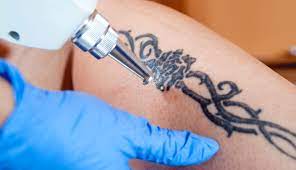If you're considering laser tattoo removal in Dubai, you're likely eager to understand what the process entails. Your first session can be both exciting and nerve-wracking, especially if you're unsure about what to expect. This guide will walk you through the key aspects of your initial laser tattoo removal session, from preparation to aftercare, ensuring you're well-informed and prepared for your treatment. let's delve into Laser Tattoo Removal Dubai.
Understanding Laser Tattoo Removal
Laser tattoo removal is a popular method for eliminating unwanted tattoos. It works by using high-intensity light beams to break down the ink particles in your skin. These particles are then gradually absorbed and eliminated by your body’s natural processes. The procedure is generally safe and effective, but there are several key things you should know before your first session.
Consultation and Pre-Treatment Preparation
Initial Consultation:
Before your first session, you'll have a consultation with your laser specialist. This is an essential step where you'll discuss your tattoo, medical history, and treatment goals. The specialist will assess the tattoo’s size, color, and location, which can impact the treatment plan. They will also explain the procedure, discuss potential risks, and set realistic expectations for the results.
Patch Test:
A patch test may be conducted to check how your skin reacts to the laser. This involves treating a small area of your tattoo to gauge your skin’s response. This helps in adjusting the laser settings for your specific skin type and tattoo characteristics.
Preparation Instructions:
You’ll receive instructions on how to prepare for the session. This may include avoiding sun exposure and certain medications that could affect your skin’s response to the laser. Ensure to follow these guidelines to minimize risks and enhance the effectiveness of the treatment.
What to Expect on the Day of Your Session
Arrival at the Clinic:
Arrive at the clinic a bit early to complete any necessary paperwork and to discuss any last-minute questions with your technician. You may be asked to remove any makeup or skincare products from the area being treated.
Preparation:
Before starting the laser treatment, the area of your tattoo will be cleaned and, in some cases, shaved if there's any hair. Your technician will then apply protective eyewear to shield your eyes from the laser light.
Pain Management:
Laser tattoo removal can cause some discomfort. Many clinics offer numbing creams or local anesthesia to minimize pain. Discuss pain management options with your specialist beforehand so you can choose the best approach for your comfort.
During the Laser Tattoo Removal Session
Laser Application:
The laser specialist will use a handheld device to target your tattoo with laser light. You might hear a snapping or popping sound during the treatment. The sensation can be likened to a rubber band being snapped against your skin. The duration of the session will vary depending on the size and complexity of your tattoo.
Cooling Measures:
To help reduce discomfort and protect your skin, cooling devices or ice packs may be used during and after the treatment. This helps to soothe the area and minimize the risk of side effects.
Session Length:
The length of your session will depend on the size and colors of your tattoo. Smaller tattoos may take just a few minutes, while larger or more complex tattoos might require a longer treatment time.
Post-Treatment Care
Immediate Aftercare:
After the session, your tattooed skin may be red, swollen, and tender. This is a normal reaction. Your technician will provide you with aftercare instructions, which typically include keeping the area clean and dry, applying prescribed ointments, and avoiding direct sunlight.
Managing Side Effects:
Common side effects include redness, swelling, and scabbing. These usually resolve within a few weeks. It's important not to pick at the scabs, as this can lead to scarring or infection. Your specialist may recommend over-the-counter pain relief if necessary.
Avoiding Sun Exposure
Protecting the treated area from the sun is crucial. UV exposure can lead to pigmentation changes and affect the healing process. Use sunscreen with a high SPF and avoid direct sun exposure as much as possible.
Follow-Up Appointments:
Multiple sessions are typically required to completely remove a tattoo, depending on its size, color, and depth. Your specialist will schedule follow-up appointments based on your tattoo's progress and your skin’s healing response.
Setting Realistic Expectations
Results and Duration:
Laser tattoo removal is a gradual process. You may not see immediate results after your first session. The ink is broken down over time, and multiple treatments are usually necessary. Patience and consistency are key to achieving the desired outcome.
Possible Variations in Results:
The effectiveness of the treatment can vary based on the tattoo's characteristics and your skin type. Some colors and types of ink are more difficult to remove and may require additional sessions or alternative treatments.
Choosing the Right Clinic
Selecting a reputable clinic in Dubai is crucial for a successful laser tattoo removal experience. Look for a clinic with certified and experienced practitioners, modern equipment, and positive patient reviews. Ensuring that the clinic adheres to high standards of hygiene and safety will contribute to a better overall experience.
Conclusion
Your first laser tattoo removal session in Dubai is an important step towards achieving the tattoo-free skin you desire. By understanding what to expect and following the pre- and post-treatment guidelines, you can make the process smoother and more effective. Remember to maintain realistic expectations and stay in touch with your specialist throughout the treatment journey. With proper care and patience, you’ll be well on your way to successfully removing your unwanted tattoo.






Comments